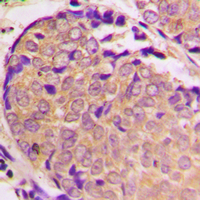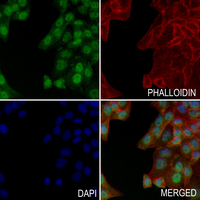Description:Rabbit polyclonal antibody to Alpha-synuclein (Phospho-S129)Immunogen:KLH-conjugated synthetic phosphopeptide corresponding to residues surrounding S129 of human Alpha-synuclein protein. The exact sequence is proprietary.Purification:The antibody was purified by immunogen affinity chromatography.Clonality:PolyclonalForm:Liquid in 0.42% Potassium phosphate, 0.87% Sodium chloride, pH 7.3, 30% glycerol, and 0.01% sodium azide.Dilution:WB (1/500 - 1/1000), IH (1/100 - 1/200), IF/IC (1/100 - 1/500)Gene Symbol:SNCAAlternative Names:NACP; PARK1; Alpha-synuclein; Non-A beta component of AD amyloid; Non-A4 component of amyloid precursor; NACP
Entrez Gene (Human):
6622;
Entrez Gene (Mouse):
20617;
Entrez Gene (Rat):
29219;
SwissProt (Human):
P37840;
SwissProt (Mouse):
O55042;
SwissProt (Rat):
P37377;
Storage/Stability:Shipped at 4°C. Upon delivery aliquot and store at -20°C for one year. Avoid freeze/thaw cycles.
-
 Western blot analysis of Alpha-synuclein (Phospho-S129) expression in HEK293T (A), mouse brain (B) whole cell lysates. (Predicted band size: 14 kD; Observed band size: 18 kD)
Western blot analysis of Alpha-synuclein (Phospho-S129) expression in HEK293T (A), mouse brain (B) whole cell lysates. (Predicted band size: 14 kD; Observed band size: 18 kD) -
 Immunohistochemical analysis of Alpha-synuclein (Phospho-S129) staining in human prostate cancer formalin fixed paraffin embedded tissue section. The section was pre-treated using heat mediated antigen retrieval with sodium citrate buffer (pH 6.0). The section was then incubated with the antibody at room temperature and detected using an HRP conjugated compact polymer system. DAB was used as the chromogen. The section was then counterstained with haematoxylin and mounted with DPX.
Immunohistochemical analysis of Alpha-synuclein (Phospho-S129) staining in human prostate cancer formalin fixed paraffin embedded tissue section. The section was pre-treated using heat mediated antigen retrieval with sodium citrate buffer (pH 6.0). The section was then incubated with the antibody at room temperature and detected using an HRP conjugated compact polymer system. DAB was used as the chromogen. The section was then counterstained with haematoxylin and mounted with DPX. -
 Immunofluorescent analysis of Alpha-synuclein (Phospho-S129) staining in MCF7 cells. Formalin-fixed cells were permeabilized with 0.1% Triton X-100 in TBS for 5-10 minutes and blocked with 3% BSA-PBS for 30 minutes at room temperature. Cells were probed with the primary antibody in 3% BSA-PBS and incubated overnight at 4 °C in a hidified chamber. Cells were washed with PBST and incubated with a AF488-conjugated secondary antibody (green) in PBS at room temperature in the dark. Phalloidin - AF594 was used to stain Actin filaments (red). DAPI was used to stain the cell nuclei (blue).
Immunofluorescent analysis of Alpha-synuclein (Phospho-S129) staining in MCF7 cells. Formalin-fixed cells were permeabilized with 0.1% Triton X-100 in TBS for 5-10 minutes and blocked with 3% BSA-PBS for 30 minutes at room temperature. Cells were probed with the primary antibody in 3% BSA-PBS and incubated overnight at 4 °C in a hidified chamber. Cells were washed with PBST and incubated with a AF488-conjugated secondary antibody (green) in PBS at room temperature in the dark. Phalloidin - AF594 was used to stain Actin filaments (red). DAPI was used to stain the cell nuclei (blue).
Progression of Parkinson's disease pathology is reproduced by intragastric administration of rotenone in mice
Contribution of Alanine-76 and Serine Phosphorylation in a-Synuclein Membrane Association and Aggregation in Yeasts
a-Synuclein expression and Nrf2 deficiency cooperate to aggravate protein aggregation, neuronal death and inflammation in early-stage Parkinson's disease
Accumulation of a-synuclein triggered by presynaptic dysfunction
Astrocyte-specific overexpression of Nrf2 delays motor pathology and synuclein aggregation throughout the CNS in the alpha-synuclein mutant (A53T) mouse model
a-Synucleinopathy associated with G51D SNCA mutation: a link between Parkinson's disease and multiple system atrophy
TDP-43 pathology in a patient carrying G2019S LRRK2 mutation and a novel p.Q124E MAPT
Deficits in dopaminergic transmission precede neuron loss and dysfunction in a new Parkinson model
Defined a-synuclein prion-like molecular assemblies spreading in cell culture
Novel AAV-based rat model of forebrain synucleinopathy shows extensive pathologies and progressive loss of cholinergic interneurons
Glucocerebrosidase depletion enhances cell-to-cell transmission of a-synuclein


 Datasheet
Datasheet MSDS
MSDS